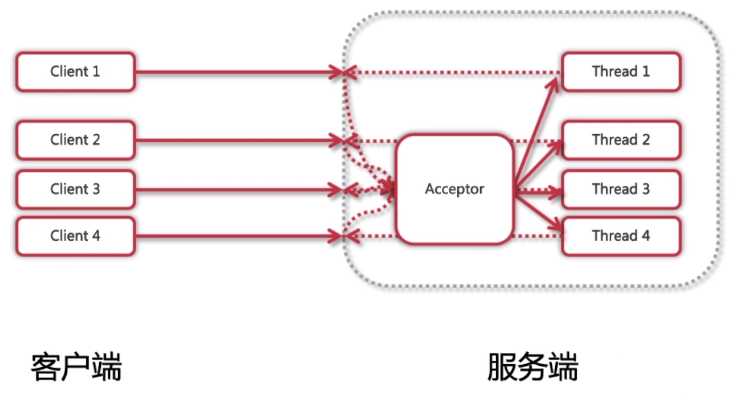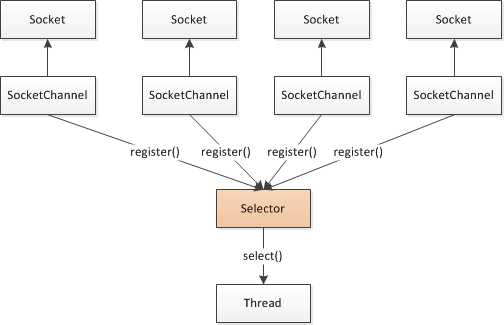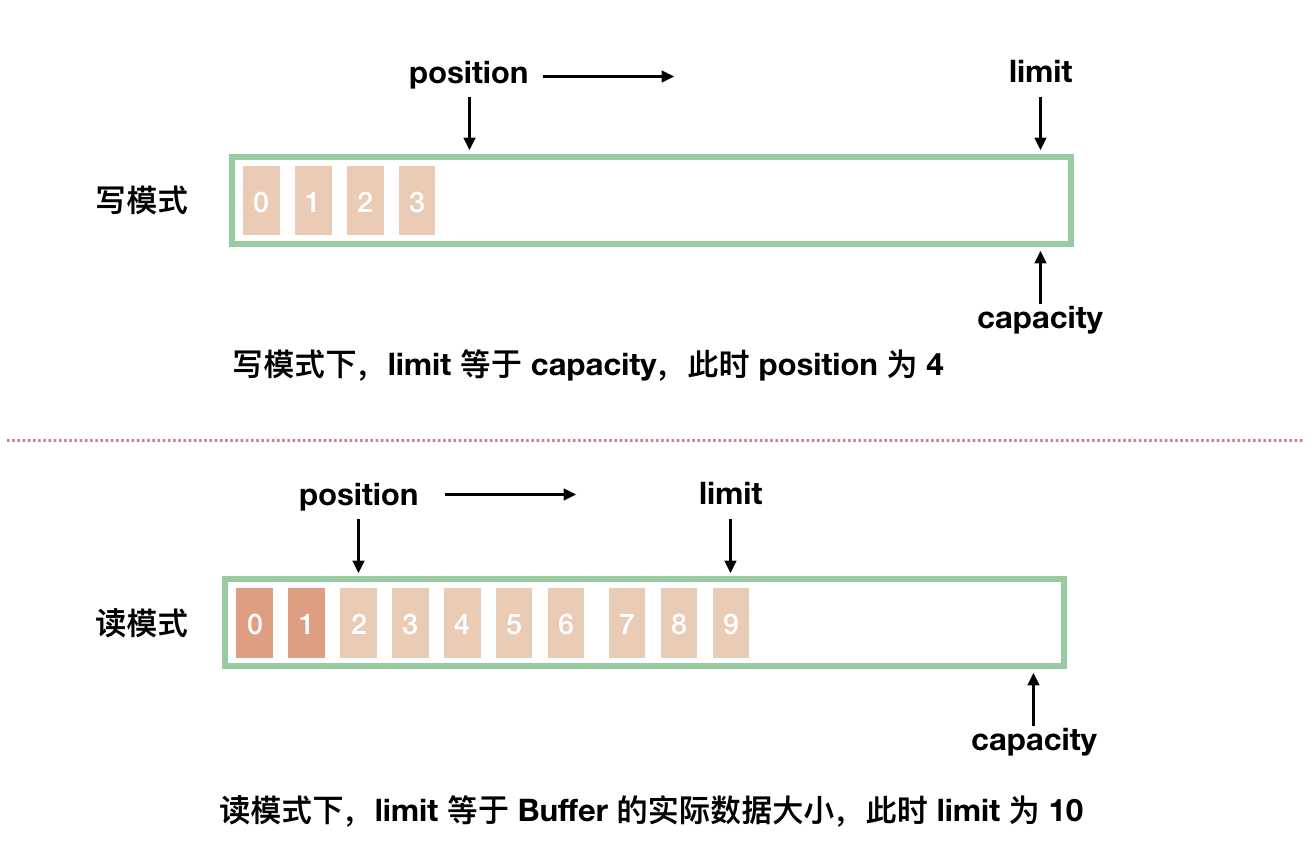标签:先来 nio的使用 数组 nios strong conf style foreach source
深入理解NIO系列分为四个部分
无论是BIO还是NIO,其实都算是一种IO模型,都是基于socket的编程,
而socket又分为两种:文件型和网络型(OS的知识,Linux的进程通讯就是socket实现的)
文件型可以简单说成是本机的通讯,也就是本地进程间的通讯(我们访问localhost应该算一个)
网络型的话就是Client-Server了,例如浏览器访问其他服务器上的网页这种。
而聊天室属于既可以在本机开两个窗口聊天,也可以和互联网上的其他主机进行聊天的那种。
所以接下来我们讲的无论是BIO还是NIO,都可以当做一个聊天室这样子去理解会简单些。
首先我们先看一下BIO的网络模型

可以看到,BIO属于来一个新的连接,我们就新开一个线程来处理这个连接,之后的操作全部由那个线程来完成的那种。
那么,这个模式下的性能瓶颈在哪里呢?
因此人们便提出了NIO

非阻塞 IO 的核心在于使用一个 Selector 来管理多个通道,可以是 SocketChannel,也可以是 ServerSocketChannel,将各个通道注册到 Selector 上,指定监听的事件。
之后可以只用一个线程来轮询这个 Selector,看看上面是否有通道是准备好的,当通道准备好可读或可写,然后才去开始真正的读写,这样速度就很快了。我们就完全没有必要给每个通道都起一个线程。
这里只给出服务端的实现,代码不难,建议贴到ide里面好好过一遍,也方便后续阅读。
/** * NIO服务器端 */ public class NioServer { private void start() throws IOException { // 1. 创建Selector Selector selector = Selector.open(); // 2. 通过ServerSocketChannel创建channel通道 ServerSocketChannel serverSocketChannel = ServerSocketChannel.open(); // 3. 为channel通道绑定监听端口 serverSocketChannel.bind(new InetSocketAddress(8000)); // 4. 设置channel为非阻塞模式 serverSocketChannel.configureBlocking(false); // 5. 将channel注册到selector上,监听连接事件 serverSocketChannel.register(selector, SelectionKey.OP_ACCEPT); System.out.println("服务器启动成功!"); // 6. 循环等待新接入的连接 for (;;) { // 获取可用channel数量 int readyChannels = selector.select(); if (readyChannels == 0) continue; // 获取可用channel的集合 Set<SelectionKey> selectionKeys = selector.selectedKeys(); Iterator iterator = selectionKeys.iterator(); while (iterator.hasNext()) { // selectionKey实例 SelectionKey selectionKey = (SelectionKey) iterator.next(); iterator.remove(); // 如果是 接入事件 if (selectionKey.isAcceptable()) { acceptHandler(serverSocketChannel, selector); } // 如果是 可读事件 if (selectionKey.isReadable()) { readHandler(selectionKey, selector); } } } } /** * 接入事件处理器 */ private void acceptHandler(ServerSocketChannel serverSocketChannel, Selector selector) throws IOException { // 如果要是接入事件,创建socketChannel SocketChannel socketChannel = serverSocketChannel.accept(); // 将socketChannel设置为非阻塞工作模式 socketChannel.configureBlocking(false); // 将channel注册到selector上,监听 可读事件 socketChannel.register(selector, SelectionKey.OP_READ); // 回复客户端提示信息 socketChannel.write(Charset.forName("UTF-8") .encode("你与聊天室里其他人都不是朋友关系,请注意隐私安全")); } /** * 可读事件处理器 */ private void readHandler(SelectionKey selectionKey, Selector selector) throws IOException { // 要从 selectionKey 中获取到已经就绪的channel SocketChannel socketChannel = (SocketChannel) selectionKey.channel(); // 创建buffer ByteBuffer byteBuffer = ByteBuffer.allocate(1024); // 循环读取客户端请求信息 String request = ""; while (socketChannel.read(byteBuffer) > 0) { // 切换buffer为读模式 byteBuffer.flip(); // 读取buffer中的内容 request += Charset.forName("UTF-8").decode(byteBuffer); } // 将channel再次注册到selector上,监听他的可读事件 socketChannel.register(selector, SelectionKey.OP_READ); // 将客户端发送的请求信息 广播给其他客户端 if (request.length() > 0) { // 广播给其他客户端 broadCast(selector, socketChannel, request); } } /** * 广播给其他客户端 */ private void broadCast(Selector selector, SocketChannel sourceChannel, String request) { // 获取到所有已接入的客户端channel Set<SelectionKey> selectionKeySet = selector.keys(); // 循环向所有channel广播信息 selectionKeySet.forEach(selectionKey -> { Channel targetChannel = selectionKey.channel(); // 剔除发消息的客户端 if (targetChannel instanceof SocketChannel && targetChannel != sourceChannel) { try { // 将信息发送到targetChannel客户端 ((SocketChannel) targetChannel).write( Charset.forName("UTF-8").encode(request)); } catch (IOException e) { e.printStackTrace(); } } }); } }
和上面的代码一模一样,但是这个有行号,方便阅读:
1 /** 2 * NIO服务器端 3 */ 4 public class NioServer { 5 6 private void start() throws IOException { 7 // 1. 创建Selector 8 Selector selector = Selector.open(); 9 10 // 2. 通过ServerSocketChannel创建channel通道 11 ServerSocketChannel serverSocketChannel = ServerSocketChannel.open(); 12 13 // 3. 为channel通道绑定监听端口 14 serverSocketChannel.bind(new InetSocketAddress(8000)); 15 16 // 4. 设置channel为非阻塞模式 17 serverSocketChannel.configureBlocking(false); 18 19 // 5. 将channel注册到selector上,监听连接事件 20 serverSocketChannel.register(selector, SelectionKey.OP_ACCEPT); 21 System.out.println("服务器启动成功!"); 22 23 // 6. 循环等待新接入的连接 24 for (;;) { 25 // 获取可用channel数量 26 int readyChannels = selector.select(); 27 28 if (readyChannels == 0) continue; 29 30 // 获取可用channel的集合 31 Set<SelectionKey> selectionKeys = selector.selectedKeys(); 32 33 Iterator iterator = selectionKeys.iterator(); 34 35 while (iterator.hasNext()) { 36 // selectionKey实例 37 SelectionKey selectionKey = (SelectionKey) iterator.next(); 38 39 iterator.remove(); 40 41 // 如果是 接入事件 42 if (selectionKey.isAcceptable()) { 43 acceptHandler(serverSocketChannel, selector); 44 } 45 46 // 如果是 可读事件 47 if (selectionKey.isReadable()) { 48 readHandler(selectionKey, selector); 49 } 50 } 51 } 52 } 53 54 /** 55 * 接入事件处理器 56 */ 57 private void acceptHandler(ServerSocketChannel serverSocketChannel, 58 Selector selector) 59 throws IOException { 60 // 如果要是接入事件,创建socketChannel 61 SocketChannel socketChannel = serverSocketChannel.accept(); 62 63 // 将socketChannel设置为非阻塞工作模式 64 socketChannel.configureBlocking(false); 65 66 // 将channel注册到selector上,监听 可读事件 67 socketChannel.register(selector, SelectionKey.OP_READ); 68 69 // 回复客户端提示信息 70 socketChannel.write(Charset.forName("UTF-8") 71 .encode("你与聊天室里其他人都不是朋友关系,请注意隐私安全")); 72 } 73 74 /** 75 * 可读事件处理器 76 */ 77 private void readHandler(SelectionKey selectionKey, Selector selector) 78 throws IOException { 79 // 要从 selectionKey 中获取到已经就绪的channel 80 SocketChannel socketChannel = (SocketChannel) selectionKey.channel(); 81 82 // 创建buffer 83 ByteBuffer byteBuffer = ByteBuffer.allocate(1024); 84 85 // 循环读取客户端请求信息 86 String request = ""; 87 while (socketChannel.read(byteBuffer) > 0) { 88 89 // 切换buffer为读模式 90 byteBuffer.flip(); 91 92 // 读取buffer中的内容 93 request += Charset.forName("UTF-8").decode(byteBuffer); 94 } 95 96 // 将channel再次注册到selector上,监听他的可读事件 97 socketChannel.register(selector, SelectionKey.OP_READ); 98 99 // 将客户端发送的请求信息 广播给其他客户端 100 if (request.length() > 0) { 101 // 广播给其他客户端 102 broadCast(selector, socketChannel, request); 103 } 104 } 105 106 /** 107 * 广播给其他客户端 108 */ 109 private void broadCast(Selector selector, 110 SocketChannel sourceChannel, String request) { 111 // 获取到所有已接入的客户端channel 112 Set<SelectionKey> selectionKeySet = selector.keys(); 113 114 // 循环向所有channel广播信息 115 selectionKeySet.forEach(selectionKey -> { 116 Channel targetChannel = selectionKey.channel(); 117 118 // 剔除发消息的客户端 119 if (targetChannel instanceof SocketChannel 120 && targetChannel != sourceChannel) { 121 try { 122 // 将信息发送到targetChannel客户端 123 ((SocketChannel) targetChannel).write( 124 Charset.forName("UTF-8").encode(request)); 125 } catch (IOException e) { 126 e.printStackTrace(); 127 } 128 } 129 }); 130 } 131 }
通过1.2的NIO部分的那张图和2.0的代码,你应该大致知道NIO的其中两大组件:Selector和Channel

这里这张图随手也把第三大组件Buffer也给了,接下来我们就先来聊一下这个Buffer
首先看一眼Buffer种类(大同小异,大同小异)

接下来讲一下它的参数:

看一下刚刚例子中对Buffer的使用(82~94行):
// 创建buffer ByteBuffer byteBuffer = ByteBuffer.allocate(1024); // 循环读取客户端请求信息 String request = ""; while (socketChannel.read(byteBuffer) > 0) { // 切换buffer为读模式 byteBuffer.flip(); // 读取buffer中的内容 request += Charset.forName("UTF-8").decode(byteBuffer); }
其中的flip方法,其实也就是设置了一下 position 和 limit 值罢了。
public final Buffer flip() { limit = position; // 将 limit 设置为实际写入的数据数量 position = 0; // 重置 position 为 0 mark = -1; // mark 之后再说 return this; }
其他的read和write方法也不过是对三个参数的操作和读取写入buffer数组的综合而已,这里就不一一分析(大同小异,大同小异)
其它的方法我也就不介绍了,要用的时候自己去查api就是了。

Channel 经常翻译为通道,类似 IO 中的流,用于读取和写入。它与前面介绍的 Buffer 打交道,读操作的时候将 Channel 中的数据填充到 Buffer 中,而写操作时将 Buffer 中的数据写入到 Channel 中。
这里是例子中对ServerSocketChannel的应用(10~17行)
// 2. 通过ServerSocketChannel创建channel通道 ServerSocketChannel serverSocketChannel = ServerSocketChannel.open(); // 3. 为channel通道绑定监听端口 serverSocketChannel.bind(new InetSocketAddress(8000)); // 4. 设置channel为非阻塞模式 serverSocketChannel.configureBlocking(false);
还有就是对SocketChannel的应用(60~64行)
// 如果要是接入事件,创建socketChannel SocketChannel socketChannel = serverSocketChannel.accept(); // 将socketChannel设置为非阻塞工作模式 socketChannel.configureBlocking(false);
到这里,我们应该能理解 SocketChannel 了,它不仅仅是 TCP 客户端,它代表的是一个网络通道,可读可写。
而ServerSocketChannel 不和 Buffer 打交道了,因为它并不实际处理数据,它一旦接收到请求后,实例化 SocketChannel,之后在这个连接通道上的数据传递它就不管了,因为它需要继续监听端口,等待下一个连接。
那么,整出Channel后该怎么办呢?当然是把它注册到Selector上了。
我们先整一个Selector出来(7~8行):
// 1. 创建Selector Selector selector = Selector.open();
然后把ServerSocketChannel注册上去(16~21行):
// 4. 设置channel为非阻塞模式 serverSocketChannel.configureBlocking(false); // 5. 将channel注册到selector上,监听连接事件 serverSocketChannel.register(selector, SelectionKey.OP_ACCEPT); System.out.println("服务器启动成功!");
这里可以看到注册的另一个参数 SelectionKey.OP_ACCEPT :
register 方法的第二个 int 型参数(使用二进制的标记位)用于表明需要监听哪些感兴趣的事件,共以下四种事件:
SelectionKey.OP_READ 对应 00000001,通道中有数据可以进行读取
SelectionKey.OP_WRITE 对应 00000100,可以往通道中写入数据
SelectionKey.OP_CONNECT 对应 00001000,成功建立 TCP 连接
SelectionKey.OP_ACCEPT 对应 00010000,接受 TCP 连接
SocketChannel 同理:
// 如果要是接入事件,创建socketChannel SocketChannel socketChannel = serverSocketChannel.accept(); // 将socketChannel设置为非阻塞工作模式 socketChannel.configureBlocking(false); // 将channel注册到selector上,监听 可读事件 socketChannel.register(selector, SelectionKey.OP_READ);
接下来就是循环检测selector中有没有准备好的channel了(23~31行):
// 6. 循环等待新接入的连接 for (;;) { // 获取可用channel数量 int readyChannels = selector.select(); if (readyChannels == 0) continue; // 获取可用channel的集合 Set<SelectionKey> selectionKeys = selector.selectedKeys();
这里只提一下select()方法
调用此方法,会将上次 select 之后的准备好的 channel 对应的 SelectionKey 复制到 selected set 中。如果没有任何通道准备好,这个方法会阻塞,直到至少有一个通道准备好。

参考资料:
https://javadoop.com/post/java-nio 参考组件部分
https://www.imooc.com/learn/1118 参考图片部分
http://www.mamicode.com/info-detail-2461800.html 参考图片部分
标签:先来 nio的使用 数组 nios strong conf style foreach source
原文地址:https://www.cnblogs.com/fatmanhappycode/p/12345391.html